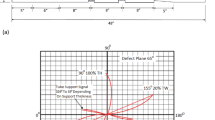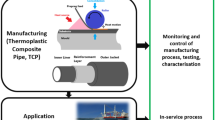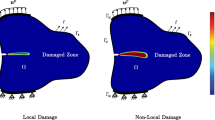Abstract
An accurate constitutive model lays an analytical foundation for the thin-walled tube plastic joining process. This study obtained the best-fitted constitutive model to accurately simulate the steel/aluminum thin-walled tubes cracking during plastic joining. The process of establishing the constitutive model comprises three parts: 1) The flow stress model of AA6061 was determined by comparing the fit of seven flow stress models and experiments, and the model parameters were calibrated using a genetic algorithm. 2) A method combined with experiment and simulation was adopted to obtain the failure parameters in the ductile fracture criterion. 3) Combinations of different ductile fracture criteria and yield criteria were implemented into the VUMAT subroutine to simulate uniaxial tension. The constitutive model of AA6061 was determined based on the comparison of simulation and experiment. Subsequently, the constitutive model was applied to the cracking prediction of the steel/aluminum thin-walled tube plastic joining process. The predicted cracking was compared with the experimental cracking. Finally, the cracking risk areas were evaluated by the forming limit diagram. The results indicated that the Voce-Swift model could better reflect the trend of AA6061 flow stress and the genetic algorithm could effectively improve the Voce-Swift model fitting accuracy. The uniaxial tensile simulation suggested that the Cockcroft-Latham criterion combined with the Hill48 anisotropic criterion could accurately predict the fracture of AA6061. Moreover, the steel/aluminum joint simulation cracking matched very well with the experiment, which verified the validity of the constitutive model in predicting cracking during the plastic joining process. Finally, the aluminum/aluminum joint simulation result proved that the risk of cracking in the upper tube was more significant than in the lower tube. The AA6061 tube with poor plasticity should be the lower tube to improve the formability of the steel/aluminum joint.





















Similar content being viewed by others
References
Czerwinski F (2021) Current trends in automotive lightweighting strategies and materials. Materials (Basel) 14(21):6631–6657. https://doi.org/10.3390/ma14216631
Ma QH, Sun JR, Gan XH, Sun ZY (2020) Experiment and modified model for CFRP/steel hybrid tubes under the quasi-static transverse loading. Int J Crashworthiness 26(3):343–353. https://doi.org/10.1080/13588265.2020.1717918
Liu QXX, Yao YH, Xia ZH, Li GY, Cui JJ, Jiang H (2021) A novel method for joining steel/Al tube parts based on electromagnetic force by flat coil. Coatings 11(11). https://doi.org/10.3390/coatings11111356
Ivanjko M, Meschut G (2018) Innovative joining technology for multi-material applications with high manganese steels in lightweight car body structures. Weld World 63(1):97–106. https://doi.org/10.1007/s40194-018-0648-9
Li H, Yang JC, Chen GY, Liu X, Zhang Z, Li GJ, Liu WH (2021) Towards intelligent design optimization: Progress and challenge of design optimization theories and technologies for plastic forming. Chin J Aeronaut 34(2):104–123. https://doi.org/10.1016/j.cja.2020.09.002
Alves LM, Silva CMA, Martins PAF (2014) End-to-end joining of tubes by plastic instability. J Mater Process Technol 214(9):1954–1961. https://doi.org/10.1016/j.jmatprotec.2014.04.011
Alves LM, Nielsen CV, Silva CMA, Martins PAF (2017) Joining end-to-end tubing of dissimilar materials by forming. Int J Press Vessels Pip 149:24–32. https://doi.org/10.1016/j.ijpvp.2016.11.006
Alves LM, Afonso RM, Martins PAF (2021) A new deformation assisted tube-to-tubesheet joining process. Thin-Walled Struct 163:107784–107791. https://doi.org/10.1016/j.tws.2021.107784
Alves LM, Reis TJ, Afonso RM, Martins PAF (2021) Singlestroke attachment of sheets to tube ends made from dissimilar materials. Materials (Basel) 14(4):815–828. https://doi.org/10.3390/ma14040815
Alves LM, Afonso RM, Silva FLR, Martins PAF (2019) Deformation-assisted joining of sheets to tubes by annular sheet squeezing. Materials (Basel) 12(23):3909–3921. https://doi.org/10.3390/ma12233909
Silva CMA, Nielsen CV, Alves LM, Martins PAF (2015) Environmentally friendly joining of tubes by their ends. J Clean Prod 87:777–786. https://doi.org/10.1016/j.jclepro.2014.10.022
Yu HY, Li JX, He ZZ (2018) Formability assessment of plastic joining by compression instability for thin-walled tubes. Int J Adv Manuf Technol 97(9–12):3423–3430. https://doi.org/10.1007/s00170-018-2128-1
Agrawal AK, Narayanan RG (2020) Experimental and numerical studies on joining steel tubes by end forming. J Constr Steel Res 167:105792–105805. https://doi.org/10.1016/j.jcsr.2019.105792
Haley JA, Kyriakides S (2020) Bending induced wrinkling and creasing in axially crushed aluminum tubes. Int J Solids Struct 202:368–383. https://doi.org/10.1016/j.ijsolstr.2020.06.003
Ablat MA, Qattawi A (2016) Numerical simulation of sheet metal forming: a review. Int J Adv Manuf Technol 89(1–4):1235–1250. https://doi.org/10.1007/s00170-016-9103-5
Rotpai U, Arlai T, Nusen S, Juijerm P (2022) Novel flow stress prediction and work hardening behavior of aluminium alloy AA7075 at room and elevated temperatures. J Alloys Compd 891. https://doi.org/10.1016/j.jallcom.2021.162013
Joun MS, Razali MK, Jee CW, Byun JB, Kim MC, Kim KM (2022) A review of flow characterization of metallic materials in the cold forming temperature range and its major issues. Materials 15(8):2751–2782. https://doi.org/10.3390/ma15082751
Reddy BV, Kondayya D, Goud EV, Reddy PV (2021) Yield criterion influence on the formability prediction of SS 304 by tensile tests and bulge tests during tube hydroforming process. Multiscale Multidiscip Model Exp Des 4(4):293–302. https://doi.org/10.1007/s41939-021-00096-4
Hu GL, Pan CR (2020) Investigation of the plastic hardening of metal thin-walled tube under pulsating hydraulic loading condition. J Mech Sci Technol 34(11):4743–4751. https://doi.org/10.1007/s12206-020-1031-5
Omer K, Butcher C, Worswick M (2020) Characterization and application of a constitutive model for two 7000-series aluminum alloys subjected to hot forming. Int J Mech Sci 165:105218–105236. https://doi.org/10.1016/j.ijmecsci.2019.105218
Ibáñez R, Abisset-Chavanne E, González D, Duval JL, Cueto E, Chinesta F (2018) Hybrid constitutive modeling: data-driven learning of corrections to plasticity models. IntJ Mater Form 12(4):717–725. https://doi.org/10.1007/s12289-018-1448-x
Yao D, Duan YC, Li MY, Guan YP (2021) Hybrid identification method of coupled viscoplastic-damage constitutive parameters based on BP neural network and genetic algorithm. Eng Fract Mech 257. https://doi.org/10.1016/j.engfracmech.2021.108027
Pourhamid R, Shirazi A (2020) A comprehensive damage criterion in tube hydroforming. Proc Inst Mech Eng Part B J Eng Manuf 235(3):417–430. https://doi.org/10.1177/0954405420962968
Ai S, Long H (2019) A review on material fracture mechanism in incremental sheet forming. Int J Adv Manuf Technol 104(1–4):33–61. https://doi.org/10.1007/s00170-019-03682-6
Park N, Stoughton TB, Yoon JW (2020) A new approach for fracture prediction considering general anisotropy of metal sheets. Int J Plast 124:199–225. https://doi.org/10.1016/j.ijplas.2019.08.011
Chang ZD, Chen J (2021) Analytical modeling of fracture strain and experimental validation in incremental sheet forming. J Mater Process Technol 294:117118–117127. https://doi.org/10.1016/j.jmatprotec.2021.117118
Quach H, Kim YS (2021) Effect of non-associated flow rule on fracture prediction of metal sheets using a novel anisotropic ductile fracture criterion. Int J Mech Sci 195:106224–106244. https://doi.org/10.1016/j.ijmecsci.2020.106224
Wu RH, Hu Q, Li M, Cai S, Chen J (2021) Evaluation of the forming limit of incremental sheet forming based on ductile damage. J Mater Process Technol 287:116497–116504. https://doi.org/10.1016/j.jmatprotec.2019.116497
Li R, Zheng ZB, Zhan M, Zhang HR, Lei YD (2021) A comparative study of three forms of an uncoupled damage model as fracture judgment for thin-walled metal sheets. Thin-Walled Struct 169:108321–108335. https://doi.org/10.1016/j.tws.2021.108321
Li R, Zheng ZB, Zhan M, Zhang HR, Cui XL, Lei YD (2022) Fracture prediction for metal sheet deformation under different stress states with uncoupled ductile fracture criteria. J Manuf Process 73:531–543. https://doi.org/10.1016/j.jmapro.2021.11.023
Ju K, Zhu FH, Li XF, Hu Q, Chen J (2020) Development of uncoupled anisotropic ductile fracture criteria. J Mater Eng Perform 29(2):1282–1295. https://doi.org/10.1007/s11665-020-04592-5
Barnwal VK, Lee SY, Choi J, Kim JH, Barlat F (2021) Performance review of various uncoupled fracture criteria for TRIP steel sheet. Int J Mech Sci 195:106269–106288. https://doi.org/10.1016/j.ijmecsci.2021.106269
Swift HW (1952) Plastic instability under plane stress. J Mech Phys Solids 1(1):1–18. https://doi.org/10.1016/0022-5096(52)90002-1
Ghosh AK (1980) A physically-based constitutive model for metal deformation. Acta Metall 28(11):1443–1465. https://doi.org/10.1016/0001-6160(80)90046-2
Voce E (1955) Empirical formulae for the determination of stress curves. J R Aeronaut Soc 59(533):362–364. https://doi.org/10.1017/S0368393100117626
Tome C, Canova GR, Kocks UF, Christodoulou N, Jonas JJ (1984) The relation between macroscopic and microscopic strain hardening in F.C.C. polycrystals. Acta Metall 32(10):1637–1653. https://doi.org/10.1016/0001-6160(84)90222-0
Hockett JE, Sherby OD (1975) Large strain deformation of polycrystalline metals at low homologous temperatures. J Mech Phys Solids 23(2):87–98. https://doi.org/10.1016/0022-5096(75)90018-6
Koc P, Štok B (2004) Computer-aided identification of the yield curve of a sheet metal after onset of necking. Comput Mater Sci 31(1):155–168. https://doi.org/10.1016/j.commatsci.2004.02.004
Banabic D, Sester M (2012) Influence of material models on the accuracy of the sheet forming simulation. Mater Manuf Process 27(3):273–277. https://doi.org/10.1080/10426914.2011.578005
Hill R (1948) A theory of the yielding and plastic flow of anisotropic metals. Proc R Soc Lond Ser A Math Phys Sci 193(1033):281–297. https://doi.org/10.1098/rspa.1948.0045
Cockcroft MG, Latham DJ (1966) A simple criterion of fracture for ductile metals
Clift SE, Hartley P, Sturgess CEN, Rowe GW (1990) Fracture prediction in plastic deformation processes. Int J Mech Sci 32(1):1–17. https://doi.org/10.1016/0020-7403(90)90148-C
Muiruri A, Maringa M, du Preez W (2022) Development of VUMAT and VUHARD Subroutines for simulating the dynamic mechanical properties of additively manufactured parts. Materials (Basel) 15(1):372–403. https://doi.org/10.3390/ma15010372
Hill R (1952) On discontinuous plastic states, with special reference to localized necking in thin sheets. J Mech Phys Solids 1(1):19–30. https://doi.org/10.1016/0022-5096(52)90003-3
Funding
The authors appreciated the financial support from the Natural Science Foundation of Shanghai, China(19ZR1460100).
Author information
Authors and Affiliations
Contributions
All authors contributed to the study conception and design. Experiments and simulation analysis were performed by Hangyu Wu. The first draft of the manuscript was written by Hangyu Wu and Haiyan Yu reviewed and edited the manuscript. All authors read and approved the final manuscript.
Corresponding author
Ethics declarations
Ethics approval
The research does not involve human participants or animals and the authors warrant that the paper fulfills the ethical standards of the journal.
Consent to participate
All the authors listed have approved the manuscript and consented to participate.
Consent for publication
All the authors consented for publication.
Competing interests
The authors declare no competing interests.
Additional information
Publisher's note
Springer Nature remains neutral with regard to jurisdictional claims in published maps and institutional affiliations.
Rights and permissions
Springer Nature or its licensor (e.g. a society or other partner) holds exclusive rights to this article under a publishing agreement with the author(s) or other rightsholder(s); author self-archiving of the accepted manuscript version of this article is solely governed by the terms of such publishing agreement and applicable law.
About this article
Cite this article
Wu, H., Yu, H. A constitutive model for cracking prediction of steel/aluminum thin-walled tubes during plastic joining. Int J Adv Manuf Technol 127, 2357–2370 (2023). https://doi.org/10.1007/s00170-023-11636-2
Received:
Accepted:
Published:
Issue Date:
DOI: https://doi.org/10.1007/s00170-023-11636-2




